Up since July 2019 the App + Web properties of Google Analytics are finally out of beta and have been given a new name: Google Analytics 4. The name has changed to reflect the fact that this type of property can be used by all companies, not just those that have an app and a website.
I have already written about some features of this type of property (still in beta) but in this article I will bring a more comprehensive view and the benefits of the new Google Analytics 4 (GA4).
Index
- What is Google Analytics 4?
- Benefits of Google Analytics 4
- Getting Started with Google Analytics 4
- Advanced Features
- How does Google Analytics 4 collect and process data?
- Events in Google Analytics 4
- More Reliable Data
- The next generation of reporting and analysis
- Missing Resources
- When to set up a GA4 property?
- In conclusion
What is Google Analytics 4?
For 15 years Google Analytics has undergone improvements but I would say none as significant as those introduced with GA4. GA data modeling to date has always focused on the visitor session, leaving something to be desired in more predictive analytics, cross-device tracking, and data control.
Until the advent of Google Analytics 4 there were two types of properties: Universal Analytics (for websites) and Google Analytics for Firebase (for apps). The intersection of the information collected at these two properties was never possible since their data modeling was different.
GA4 is designed for all Analytics users: those who only have a website, those who only have an application, and those who have both and want to combine all data in one place.
Benefits of Google Analytics 4
Google Analytics 4 is the next generation of analytics tools. It was designed to enable business scalability and to be measurable across devices and platforms.

Making use of machine learning aims to provide predictions and help improve companies’ marketing efforts. For example, this technology can be used to predict results such as churn and potential revenue for a given segment.
Moreover, it is aligned with privacy criteria that no analytics tool has demonstrated to date. In view of the end of the use of cookies scheduled for 2022, the data shortage will become ever greater. The use of machine learning in Analytics comes in to fill any data gaps left by the absence of cookies.
Check out some benefits of using GA4 properties:
- It allows you to measure, unify, and de-duplicate the interactions that users have with your company across different devices and platforms. This provides a more complete and relevant understanding of the visitor’s journey;
- It offers more durable monitoring, meeting users’ expectations for privacy while providing long-term results;
- It facilitates insight discovery through Google’s machine learning.
Getting Started with Google Analytics 4
Regardless of the size and degree of digital maturity your company is at, it is important to adopt an analytics tool that can keep up with the growth of your business.
By creating a GA4 property you will:
- Start building historical data that will make future analysis and reporting more meaningful, understanding trends and insights over a longer period of time;
- Enable you to take advantage of all the new features in terms of web analytics that will contribute to new insights from your data.
Advanced Features
The Google Analytics 4 property has powerful features. They include:
- Analysis: greater freedom in interpreting the data collected. You can use a variety of techniques such as funnel analysis, visitor flow, retention, and more.
- Export to BigQuery: previously this feature was exclusive to GA360 subscribers but is now available to everyone. You will be able to export your analytics data to BigQuery, either for storage or future use by integrating with other data sources.
How does Google Analytics 4 collect and process data?
As I mentioned in another article on App + Web properties (now GA4), the data modeling of this type of property is quite different from what we are used to seeing with Google Universal Analytics.
Instead of using a session-based model, which groups user interactions within a given time period, Google Analytics 4 uses an event-based model, which processes each user interaction as a standalone event.
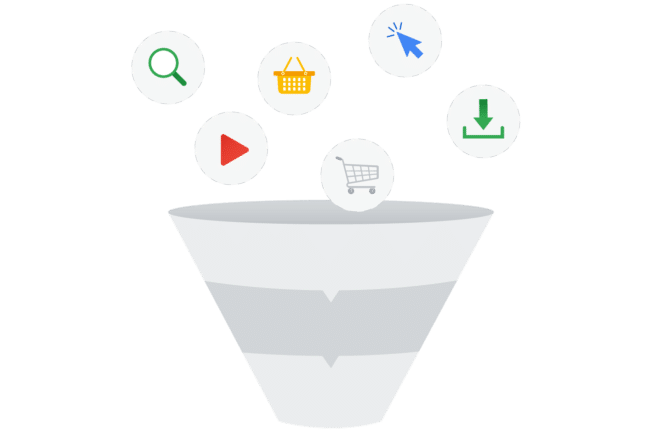
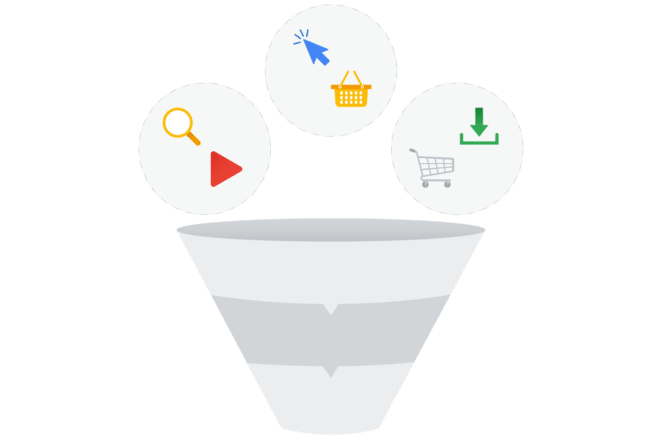
Benefits of the event-based model
Event-based data collection allows GA to be more flexible, scalable, and able to perform more customized calculations more quickly.
If your business makes use of a website and an app, it is important to track a variety of interactions to understand people’s behavior with your company. You could measure it, for example:
- clicks and pageviews on the site;
- installations and opening your application;
- engagement and conversion on any of the platforms.
The event-based model constantly measures interactions between devices and platforms and provides enhanced insight into incoming data.
Please note: the measurement protocol has also been updated and improved. If your business has connected points of sale, machines, or kiosks you will need to update these integrations. Oh, and if this is new, yes, you can connect other devices to GA other than websites or apps.
Events in Google Analytics 4
Unlike previous versions of Google Analytics, GA4 tracks basic interactions with your site in an automated way, without the need for additional configuration. For example, a user’s first visit to the site will record an event of the type first_visit.
During setup you can (and should) also enable the enhanced measurement feature, which allows you to automatically collect more events without having to mess with a single line of site code. The enhanced measurement allows you to track pageviews, scrolls, external links, search, downloads, and video views.
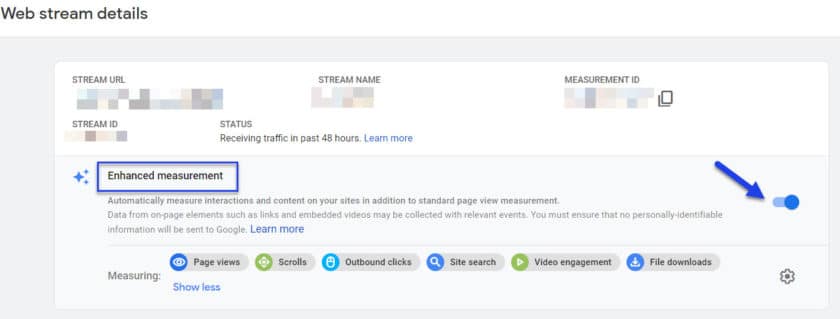
Read also: How to install Google Analytics using Google Tag Manager
More Reliable Data
With Google Analytics 4 you can identify users across different devices and platforms. With Universal GA this identification was restricted to the device identification.

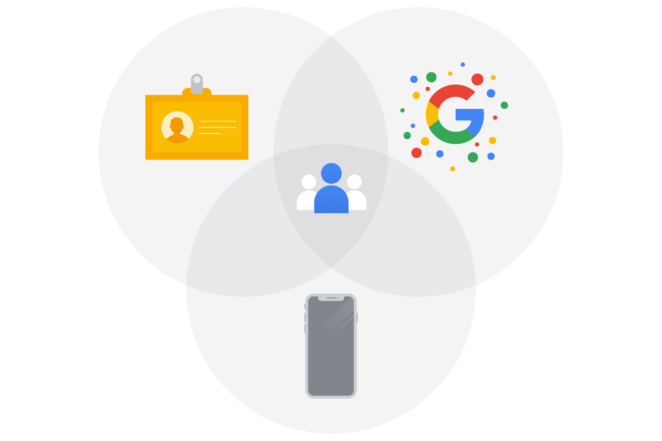
The user identification takes place in three ways (sequential):
- User ID (if logged in to your site);
- Google signals (data from users who may be logged into Google and have agreed to share their information);
- Device ID.
With GA4 you will be able to answer the following questions:
- How many unique users do you have, regardless of the platform they use?
- How many conversions have occurred on your application or website in the last week?
- Which platform is contributing more to conversions?
You will also better understand the effectiveness of your campaigns across platforms. It is possible to know, for example, how many users started on your app and then visited your online store to make a purchase.
The next generation of reporting and analysis

Reporting and analytics is to Google Analytics as bread is to butter. Reports are designed to provide actionable insights into the website and app at the right time.
The reports in a Google Analytics 4 property are similar to the reports in Universal GA, at first glance. There are some differences:
Reporting and Analysis in Universal Analytics
Historically, GA has organized its data into predefined reports designed to reveal valuable insights. As more features were added more reports were created, until we got to the gigantic volume of reports we have today.
If you have used (traditional) GA you may have noticed that it is possible to customize these reports, but only to a certain extent. If the information you are looking for is not available you will have difficulties.
Simplified reporting on GA4 properties
In Google Analytics 4 properties, reporting is simplified. Instead of a dozen or so predefined reports you get one simplified report with the most relevant information.
If you want more details on any topic, just identify the option for more details on the card.
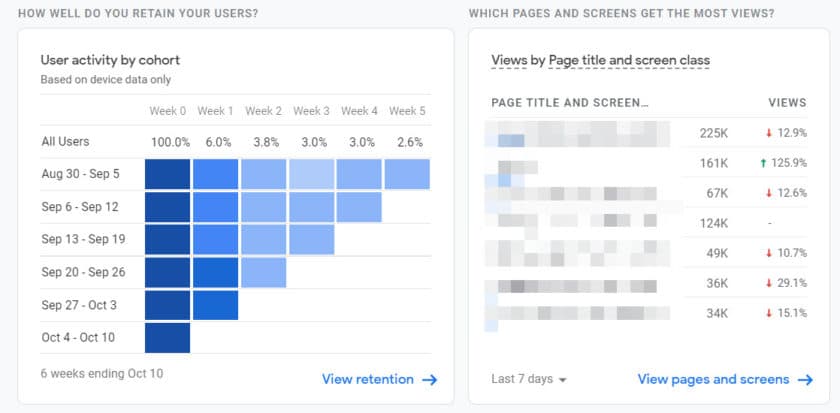
Exploring Data with Google Analytics 4
Say you are looking for insights that the reports do not cover, the analytics feature allows you to analyze the data in a more customizable way. In analytics you can drag and drop dimensions and metrics that you are interested in. In addition, you can filter, segment, sort, and refactor your data according to your interest.
Once you discover a data set/analysis that is relevant to your business, you can export it as a Google Analytics segment or audience. These segments can be used by different parts of the organization, and can be exported to other tools (e.g. Google Ads).
You can also use the search box at the top of your GA account to find what you need. You can ask for insights, locate reports, and even go to other properties and accounts in a more streamlined way.
Read also: Digital Marketing Metrics: which ones are important?
Missing Resources
Despite all the features of Google Analytics 4, you may miss some functionality (at least for now):
- E-commerce reporting (enhanced);
- Internal research reports;
- Filters (e.g. IP filtering);
- Connector with Google Data Studio (although it can be done via BigQuery).
Google is working to provide additional features for GA4 and no doubt we will have others soon. Keep an eye on the release notes.
When to set up a GA4 property?
Although it is not possible to transfer data from Universal GA to GA4, since the data modeling is quite different, it is quite convenient to start using GA4 now.
Using Google Analytics 4 you will begin to build a database that can serve for future insights. Nevertheless, you will be familiarizing yourself with the tool.
If you currently use a Universal Analytics property, set up a GA4 property in parallel to take advantage of new features as they emerge.
If you don’t use GA yet, the Google Analytics 4 property has become the default GA property. I recommend that you start taking advantage of it as soon as possible.
In conclusion
The new Google Analytics 4 (formerly App + Web) properties take a huge step into the future of analytics tools.
Making use of Google’s machine learning, these properties are able to provide insights and predictive analytics that promise to take your business to the next level.
GA4 offers much more integration with other tools and greater knowledge of audiences and customer lifecycle. All this while preserving the user’s privacy to a level never before seen in an analytics tool.
Furthermore, the configuration and follow-up of events is practically all automated, with no need for maintenance of codes installed on the site.
The more simplified reports are objective but also allow for exploration in detail if needed.
GA4’s analytics hub is excellent and, if used well, will bring insights impossible to get with Universal Analytics and other web analytics tools.
I already use the GA4 property for most of my clients. And you?
If you need help using this powerful tool, get to know my consulting services or contact me!
Oh, you can find a free Google training on GA4 at this link. It is quick and gives a good insight into the topic.
Image credit: Google
